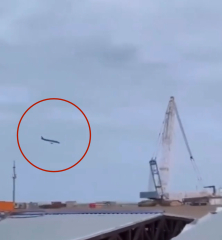The pilots of a Delta Connection flight experienced a fire in the cockpit, forcing the New York-bound flight to return to its origin.
The Incident
According to the Transportation Safety Board of Canada (TSB), an Endeavor Airlines Bombardier CRJ-900 operating flight 4826 between Toronto (YYZ) and New York (JFK) was forced to return to YYZ after declaring an emergency. The pilot returned due to a "burnt electrical smell" in the regional jet's cockpit. The aircraft involved in the incident is N320PQ, a 9.7-year-old Bombardier CRJ-900LR.
The TSB has said it is actively investigating the aforementioned incident, which occurred on February 3. As Flight 4826 passed 11,000 feet (3,353 meters), the pilots declared an emergency, and the flight began to return to Toronto. TSB investigators primarily focus on physical evidence of a potential technical fault in the CRJ-900.

Complementing the physical evidence in the investigation are the pilots' accounts of what happened during the flight. One factor that may help investigators determine the cause of the incident is the Air Traffic Control (ATC) communications between the pilots and Toronto ATC.
One of the pilots can be heard saying the following to ATC:
"MAYDAY- MAYDAY - MAYDAY, this is Endeavor 4826, declaring an emergency; just had a fire. An electrical fire up in the cockpit. Looks like it's out currently. Requesting return to Toronto immediately."
As Toronto ATC vectored the flight back towards YYZ, the pilots reported extinguishing the fire, saying:
"And it appears the fire is out. We had a spark-up and flare-up on our windshield, it looks like. Fire appears to be out. We should be able to exit the runway, but we'll have fire trucks take us all the way to the gate. Looks like the windshield heater sparked up."

After landing at YYZ, the CRJ-900 was checked by firefighters for any potential fire damage before the flight was escorted to its gate by fire trucks. Firefighters and the captain of Flight 4826 later confirmed that the fire had originated from the captain's side of the cockpit windshield. None of the 74 people onboard the flight were injured by the incident.
A spokesperson for Delta Air Lines, which owns Endeavor Air, later stated that the aircraft's windshield and heating unit were replaced.

Previous Incidents
While there are some notable examples of inflight fires, such as Swissair Flight 111 and Valu Jet 592, no inflight fire incident is more infamous than Saudia Flight 163. Seven minutes after takeoff from Riyadh, a fire broke out in the cargo hold of the Lockheed L-1011 Tri Star aircraft operating the flight. The crew in the cockpit took four minutes trying to confirm whether or not there was a fire despite warning indicators going off in the cockpit.
After four minutes, smoke was confirmed in the cockpit, and by the time flight 163 had returned to Riyadh, landed, and come to a stop, the fire was already engulfing the cabin. The cabin crew could not open the doors and emergency slides because the pilots took an additional three minutes and 15 seconds to shut off the engines of the fire-stricken L-1011. It was too late for the passengers of the flight as the fire in the cabin flashed over, killing all 301 passengers onboard.
PHOTOS: Azerbaijan Airlines E190 Crashes in Kazakhstan » South African Airways Eyes India–South Africa Route » Ethiopian Airlines Expands Fleet with Second Airbus A350-1000 »
Comments (0)
Add Your Comment
SHARE
TAGS
NEWS Fire Emergency Landing Delta Connection Endeavor Air Bombardier CRJ-900 CRJ-900 Toronto Canada New York JFK Incident Safety PilotRECENTLY PUBLISHED
 PHOTOS: Azerbaijan Airlines E190 Crashes in Kazakhstan
An Azerbaijan Airlines Embraer E190 crashed approximately 3 km from the city of Aktau today, December 25. Images from the scene show that the aircraft lost speed and then crashed, followed by a large explosion.
NEWS
READ MORE »
PHOTOS: Azerbaijan Airlines E190 Crashes in Kazakhstan
An Azerbaijan Airlines Embraer E190 crashed approximately 3 km from the city of Aktau today, December 25. Images from the scene show that the aircraft lost speed and then crashed, followed by a large explosion.
NEWS
READ MORE »
 South African Airways Eyes India–South Africa Route
As part of its recovery strategy, South African Airways (SAA) is exploring the reinstatement of direct flights between India and South Africa. SAA, along with Minister of Tourism Patricia de Lille, on December 3, 2024, participated in a high-level delegation to India to strengthen aviation and tourism ties between the two nations.
ROUTES
READ MORE »
South African Airways Eyes India–South Africa Route
As part of its recovery strategy, South African Airways (SAA) is exploring the reinstatement of direct flights between India and South Africa. SAA, along with Minister of Tourism Patricia de Lille, on December 3, 2024, participated in a high-level delegation to India to strengthen aviation and tourism ties between the two nations.
ROUTES
READ MORE »
 Ethiopian Airlines Expands Fleet with Second Airbus A350-1000
Ethiopian Airlines, Ethiopia's national carrier, has taken delivery of its second Airbus A350-1000, registered as ET-BAX. This advanced aircraft is powered by Trent XWB-97 engines, further solidifying the airline’s commitment to modernizing its fleet.
NEWS
READ MORE »
Ethiopian Airlines Expands Fleet with Second Airbus A350-1000
Ethiopian Airlines, Ethiopia's national carrier, has taken delivery of its second Airbus A350-1000, registered as ET-BAX. This advanced aircraft is powered by Trent XWB-97 engines, further solidifying the airline’s commitment to modernizing its fleet.
NEWS
READ MORE »





